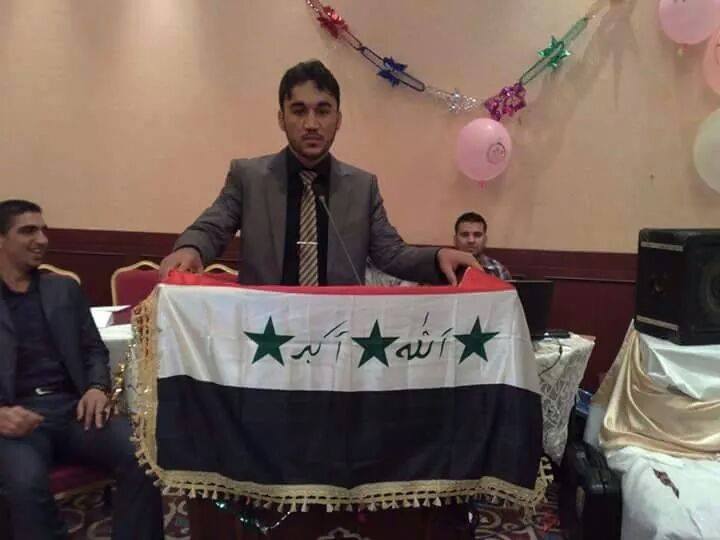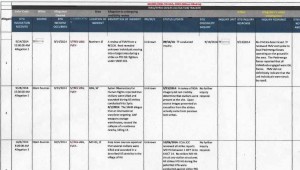Additional reporting by Kinda Haddad and Latif Habib
A newly-declassified CENTCOM document – published by Airwars and international media partners for the first time today – reveals that by early May of this year, the anti-ISIL Coalition had already internally investigated dozens of events involving at least 325 possible civilian deaths from airstrikes in Iraq and Syria.
Yet despite often significant published evidence of civilians killed in Coalition strikes, most allegations were dismissed as “Not credible” within 48 hours – with few signs of later follow-ups.
The document also reveals for the first time that French, Canadian, Dutch and Australian aircraft have all been involved in problem incidents in Iraq, which between them allegedly killed up to 30 civilians.
The previously-secret 14-page file – obtained under the Freedom of Information Act by journalist Joseph Trevithick for War Is Boring – offers a rare insight into internal military workings. It also makes clear that the US and its 12 international allies have long known of significant allegations of civilians killed in some 6,500 airstrikes – far more than the two deaths presently admitted to.
Dating to early May 2015, the document summarises a CENTCOM database known as the Iraq/Syria CIVCAS Allegation Tracker. Some 45 individual problem events are listed, ranging from September 14th 2014 to April 30th 2015.
The date and location of each alleged incident is given, as well as a summary of preliminary investigations. Thirteen cases were prompted by Coalition self-reporting rather than by any external claims, and were not previously known to Airwars. These range from pilots reporting that civilian vehicles had strayed into their killbox, to FBI informants alleging mass casualties.
The CENTCOM document also provides crucial insights into problem strikes carried out by America’s allies – details which most have kept hidden from their own publics.
Canadian strike
A Canadian airstrike on January 21st at Kisik Junction in Iraq is already front-page news in Ottowa, after it was revealed that the country’s Defence Minister had been kept in the dark about the incident.
Under pressure from the media, a Canadian Armed Forces (CAF) spokesman did recently identify the date of that strike but gave few more details, other than insisting an internal investigation had found “no evidence of civilian casualties.“
The newly declassified CENTCOM document provides far more information, revealing that between 6 and 27 civilians allegedly died in the Canadian attack. The source for that claim, we now know, was an English-speaking peshmerga fighter who passed on his concerns to Coalition Special Forces based in Iraq.
A CAF spokesman told Airwars that Canada’s own investigation of the incident – which involved reviewing video and strike records – concluded there was no case to answer: “The review uncovered no evidence of civilian casualties. Furthermore, it was re-confirmed that the target was a valid military objective from which ISIS was firing a heavy machine gun at Iraqi Kurdish troops. The area in question is still within ISIS held territory.”
Airwars researchers have found no published claims of civilians killed at Kisik that night – although some reports at the time placed the number of Islamic State fighters killed in a Kurdish offensive on the town at over 250.
‘Daesh propaganda’
Australia remains one of the least transparent members of the international Coalition against Islamic State, refusing to say where or when it bombs in Iraq. Officials insist that any published information “could be distorted and used against Australia in Daesh propaganda.”
Canberra is therefore unlikely to be happy with CENTCOM for publicly revealing that on two occasions to April 30th, Australian combat aircraft may have killed or injured civilians in Iraq.
On October 8th 2014, a Coalition strike on an ISIL checkpoint near Ramadi may also have hit a civilian truck. As the internal document notes, weapon system video from an Australian F-18 showed that “it was apparent that a truck entered the target area between weapon release and impact.” On that occasion, a more thorough review of the video led to a decision that “No further inquiry” was needed.
A woman and child may also have been injured in a major Australian airstrike at Fallujah on December 21st 2014. That attack was focused on a’suspected weapons factory’ in the city.
[pullquote]Despite the apparent seriousness of the incident, it was quickly dismissed by both Australian and US military investigators[/pullquote]Military surveillance revealed a woman and child walking through the immediate strike area some minutes after the last missile impacted. The child was then observed being taken to the local hospital, while the woman “walked to the median strip on the road and lay down, and was not observed any further.”
Despite the apparent seriousness of the incident, it was quickly dismissed by both Australian and US military investigators who decided “there is insufficient information to warrant further inquiry… The lack of urgency and fact that the child walked apparently normally suggested his injuries were not life-threatening.”
The report also claimed that there were “no Iraqi allegations of CIVCAS.” This was incorrect. Airwars researchers have identified major news reports from the time, which alleged civilians were killed by both the Coalition and the Iraq Army in Fallujah that night.
BBC Arabic for example described medical sources at the city’s main hospital as “receiving 13 bodies and seven wounded, including women and children who fell during the incessant shelling.” Those casualties were attributed both to the Iraqi military and to “air strikes launched by the international coalition on the city of Fallujah on Sunday night (21st) and until dawn Monday, targeting places where IS fighters are believed to be.”
‘Possible child’
Thirteen incidents listed in the declassified document were self-reported internally, with no matching public claims of civilian casualties. An internal post-strike assessment revealed, for example, that a child may accidentally have been caught up in a French airstrike in Mosul on February 3rd 2015.
According to CENTCOM, surveillance footage showed a “possible child entering a targeted bunker and then disappearing out of the field of view (FOV) approximately 19 minutes before Strike.”
The attack which followed, carried out by a French Mirage 2000 using a guided GBU-49 bomb, killed an estimated five enemy fighters, the report says.
Claims that a child had died were deemed “not credible” by military intelligence officers, who decided “that individuals struck were fighters.“ Airwars researchers could find no reference to a child fatality in Mosul for this date, although reports did note an intensification of Coalition strikes on the city.
Dutch aircraft were also suspected of killing two civilians in an incident on the morning of December 26th 2014. According to the document, “while conducting dynamic coalition airstrikes on ISIL fighters and technical vehicles NLD F· l6AM [ie a Dutch F-16] may have unintentionally struck two unidentified persons on motorcycles who entered the target area during the strikes.”
These claims of civilian deaths were deemed serious enough to trigger a rare formal investigation into the event. This later concluded that there was not enough evidence to indicate civilian fatalities, though neither CENTCOM nor the Dutch military has published that report. A Pentagon spokesman told Airwars in July 2015 that “after reviewing all available evidence, the allegations of civilian casualties from Coalition airstrikes in these instances were unfounded.”
A determination that no civilians had died was based partly on an assessment of the ammunition used, the declassified document suggests: “No CIVCAS found due to the Dutch using ball ammo rather than HE [high explosive] rounds.”
Airwars researchers have found no public reports of civilian fatalities for Fallujah on December 25th-26th, although there was coverage of ongoing clashes between the Iraq military and Daesh.
‘Not Credible’
Nine of the 45 alleged incidents investigated by the Coalition in the report turned out not to have been the work of international aircraft. Claims that up to 45 people died in Coalition attacks on Aleppo in Syria on December 26th 2014 were dismissed, for example, after it was found none had taken place “during the relevant time period.” On that occasion the Assad regime was most likely responsible.
On another occasion, any Coalition role in the deaths of 15 worshipers at a mosque in Iraq were ruled out after it was found that the “nearest coalition strike to Haditha was 34km and was not within close enough proximity to be considered credible.”

Yassir Rafeh was among 15 worshippers allegedly killed in a Coalition airstrike at Haditha, February 17th 2015. The declassified CENTCOM report confirms this was not the case.
On numerous other occasions CENTCOM investigators dismissed claims of civilian casualties within 48 hours based on extremely limited information. Few of these events were later re-examined, despite significant evidence of civilian deaths often emerging.
On September 23 2014 for example, US airstrikes hit al Qaeda-linked militants in the Syrian town of Kafr Daryan. Up to 13 named civilians also died that night, according to extensive video reports and eyewitness testimony from survivors.
[pullquote]A rudimentary search by CENTCOM would have identified multiple photographs and videos relating to September 23rd itself.[/pullquote]Even so CENTCOM dismissed claims of civilian deaths, in part based on an assessment that “Open source images presented as casualties from the strikes actually came from previous GoS [Government of Syria] strikes.”
Airwars has examined all known published images relating to the Kafr Daryan event. As our Syria researcher Kinda Haddad notes, “Every picture but one we are aware of first appears on 23rd September 2014, and in connection with Kafr Daryan.”
That one known exception is a picture which first appeared as a tweet on September 2nd, after a child was killed by the Assad regime. Shortly after the Kafr Daryan attack some three weeks later, that same image was claimed in English by at least one site to have been taken at Kafr Daryan.
However a rudimentary search by CENTCOM would have identified multiple photographs and videos relating to September 23rd itself. Even when investigators noted new evidence on the strike from the Syrian Network for Human Rights in April 2015, this did not appear to trigger any new inquiry.
https://twitter.com/MaryamSaleh_/status/506700720138354688/photo/1
Claims that this pictured child was killed at Kafr Daryan three weeks later helped lead CENTCOM to conclude no civilians died in a US attack
‘Insufficient information’
In another case, CENTCOM was prompted by the US State Department to reinvestigate some six months after a Coalition attack on a gas station in Syria reportedly killed three named civilians.
Weapon system video from the time was reviewed and air crews interviewed. Investigators again concluded that there was “Insufficient evidence to determine CIVCAS,” despite apparent evidence to the contrary from the ground. Yet at the same time, the CENTCOM report admits to “limited video analysis” and “intermittent visual contact with the ground.”
On April 1st 2015, CENTCOM also reassessed claims that between 50 and 60 civilians had been killed in a US attack at Al Bab, Syria four months previously. It concluded that there was still “insufficient information to determine CIVCAS.” This was partly justified by citing an Assad regime airstrike on the city some 48 hours before the US attack, “which resulted in media reports of CIVCAS as well.” Yet no reports from the time appeared to confuse these two events, both of which reportedly caused mass casualties.
Other incidents in the CENTCOM file are less conclusive. In November 2014 an FBI source alleged the deaths of “41 Yezidi captive females killed in a strike on a named OBJ IVO [objective in the vicinity of] Mosul.”
In the investigation which followed, a Coalition strike with an AGM-114 missile was identified as having taken place some 3.2km from the site of the alleged incident (suggesting that the aircraft involved was a drone.)
However, the report also noted that “the engagement conducted a cold shift on the weapon due to collateral concerns entering the area of the strike.” As a result it was concluded “No further inquiry needed.”
According to former US Air Force personnel consulted by Airwars, a ‘cold shift’ refers to the deliberate in-flight aborting of a missile to a predesignated safe spot.
While Airwars researchers have not been able to identify any published claims of mass casualties among Yazidi women in Mosul at the time, there were reports of women escaping as a result of Coalition airstrikes. One local news source cited the Director-General for Yazidi Affairs at the Ministry of Awqaf and Religious Affairs in Kurdistan as saying that “about 250 Yazidi from Mosul and Sinjar escaped during the aerial bombardment of these gatherings.”




